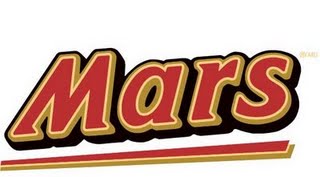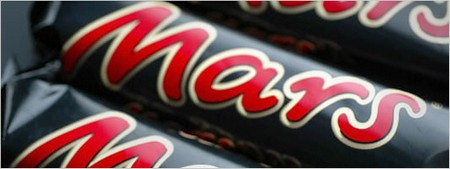History of Mars Chocolate
Mars Chocolate is one of the operating divisions of US global corporation Mars Inc, a privately owned company founded by Frank and Ethel Mars in 1920 and has grown to be one of the world’s largest confectionary brands with products such as M&Ms, Snickers, Skittles, Milky Way, Bounty, Twix, and of course the flagship chocolate candy, the Mars Bar. The company also owns several other food related brands such as Uncle Ben’s, Dolmio, Masterfoods, and Pedigree Pet Foods,
In 1911 Frank C. Mars and his second wife Ethel (nee Healy) started a confectionary factory in Tacoma, Washington known as the Mars Candy Factory, but by 1920 Frank and Ethel had relocated the factory to Minnesota under the name Mar-O-Bar but the name didn’t inspire a great deal of brand loyalty and was changed to Mars, Inc when the company incorporated a few months later.

Mars were most well known for their Milky Way chocolate bar in the 1920s a candy bar with nougat and caramel that was quite unique in those times with most other chocolate candy being simple bars of solid chocolate. The Milky Way candy sold well and allowed the company to grow to several hundred employees.
By the early 1930s Mars were able to introduce the Snickers chocolate bar with a chewy nougat and peanut interior, and coated with milk chocolate. The Snickers bar was named after a favorite horse of the Mars family but this didn’t seem to affect sales too much, quite the contrary, the simple change from snack allowed for clever puns in contemporary society helping to drive sales of the Snickers chocolate bar to levels exceeding those of the Milky Way bar.
Forrest Mars Sr, the son of Frank and Ethel Mars joined the family business a few years after it was formed, but disagreements in the family led to an estrangement and Forrest relocating to England where he formed Mars Limited at Slough. The dispute between Forrest and Frank Mars is believed to have been over Forrest’s desire to experiment with new products and promote the family’s products outside of the USA.
In 1932 things had reached an untenable situation and Forrest was given $50,000 and the recipe for the Milky Way bar and told to follow his own destiny. Arriving in England Forrest discovered the Milky Way bar wasn’t to European tastes, the malt nougat needing to be toned down and the taste of the caramel accentuated. The new product couldn’t be named Milky Way, so the name Mars was adopted and was an immediate success in England and other European nations.
The death of Frank Mars in 1934 at the age of 51 put Mars, Inc and Mars Limited into Forrest Mars Sr’s hands along with his sister Patricia, and the return of Forrest to the US as well as the merger of the two companies under the Mars, Inc name. In the US, Mars continued to sell and market the Milky Way and Snickers bars, whilst in Europe the Snickers bar was introduced under the name Marathon.
During the 1930s Forrest happened to be on a sales trip to Spain and witnessed soldiers in the Spanish civil war eating chocolate beads covered with a candy exterior that kept the beads from melting and allowed soldiers to carry them in the packs or pockets. Sensing a market for small chocolate beads Forrest set about developing his own recipe. By the time the product was ready to be introduced to the market World War 2 was underway and rations introduced in the US.
At the time the only company authorized to make chocolate for domestic and war consumption was the Hershey company, a rival to Mars, but an agreement was reached with Bruce Murrie, the son of Hershey’s president where Mars with 80% share in the new product would provide the factory and recipe, whilst Hershey with the other 20% share of the business would provide the chocolate. The two Ms on the beads were named after Forrest Mars and Bruce Murrie. Production started in 1941 but 100% of the manufactured product was diverted to soldiers until after the war ended.
As the company has grown, new factories became necessary particularly in new markets outside of Mars, Incs traditional markets of the US and UK. In 1963 a chocolate factory in the Netherlands at Veghel was opened and has continued to be expanded and also produces other foods in the Mars family of products, yet is still the largest chocolate factory owned by Mars and either the largest or second largest in the world, a fact that cannot be verified due to secrecy surrounding Mars, Inc..
A criticism of Mars chocolate has come from environmentalists and fair trade activists who claimed the company hasn’t publicly endorsed and supported the fair trade movement. Mars, Inc countered that their own program of sustainable development and partnership with cacao farmers was a more progressive approach, and cited partnerships with the Smithsonian Tropical Research Institute, the Rainforest Alliance, Conservation International, The Nature Conservancy, and the US Department of Agriculture as proof of its commitment. The private and secretive nature of Mars, Inc prevented fair trade activists from verifying Mars claims so criticism has continued.

Dove Chocolate, formerly an independent company bought by Mars, Inc in 1986, forms part of the flagship lineup of the confectionary division of Mars and allowed the company to develop non-traditional sales channels, starting with party plans and private distributors working from home. Since the 1990s Mars, Inc has successfully introduced new chocolate brands into the market such as Ethel M’s Chocolate Lounge, a gourmet product aimed at the gifts market and sold thru company owned stores in the US as well as online.
Mars, Inc also started up the American Heritage Chocolate Co with stores at major historical sites selling chocolate using authentic colonial recipes, and is active in helping to preserve chocolate history. In 2009 Mars in association with the Smithsonian Institute published a book entitled “Chocolate: The North American Experience”, a history of chocolate production and cacao processing in North America since the earliest known times.
